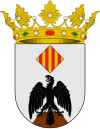Penàguila
| Penáguila | ||
|---|---|---|
| Town | ||

General view of Penáguila
|
||
|
||
| Location of Penáguila in Spain | ||
| Coordinates: 38°40′45″N 0°21′33″W / 38.67917°N 0.35917°WCoordinates: 38°40′45″N 0°21′33″W / 38.67917°N 0.35917°W | ||
| Country |
|
|
| Autonomous Community | ||
| Province | Alicante | |
| Comarca | Alcoiá | |
| Founded | 324 BC | |
| Government | ||
| • Mayor | Carlos Blanes Gisbert (PP) | |
| Demonym(s) |
alacantí, -ina (va) alicantino/a (es) |
|
| Time zone | CET (UTC+1) | |
| • Summer (DST) | CEST (UTC+2) | |
| Postal code | 03815 | |
| Area code(s) | +34 (ES) + 96 (A) | |
| Website | Official website | |
Penàguila (Valencian pronunciation: [peˈnaɣila], Spanish: Penáguila [peˈnaɣila]) is a municipality in the comarca of Alcoià, Alicante, Valencia, Spain.
Located at the foot of the Sierra de Penáguila in Pre-Baetic Valencian domain, the municipality extends from Morro Ull (1050 m), west to the top of the Creueta, east, forming part of the northern slopes of the Sierra de Aitana and open to the pit of Alcoy. The term river running through Frainós or Penáguila, east of the town, which flows into the river Alcoy Serpis or when it reaches Cocentaina.
Of Muslim origin, the villa was totally walled, and currently some ruins of the walls and towers remain.
On April 8, 1276, James I promised Lacerates Berenguer Mayor Penáguila Castle, divide the lands of the same men who guard it strength. On September 26, 1278, Peter III granted Penáguila a town charter. In 1338, Pedro of Aragon ordered the fortification of the castle. During the fifteenth and sixteenth centuries the manor belonged to the Fenollar family before it became part of the crown. Penáguila was a royal town with voting rights in the courts.
In contrary to other places in the area, Penáguila consisted of a largely Christian population, so the decree of expulsion of the Moors, in 1609, was a not important to its demographics: the 200 homes registered before expulsion were reduced to 145, and did not involve an excessive loss.
Penáguila belonged until 1707 to the governor of Xativa, and until 1833, was part of the township of Alcoy. With the provincial division of 1833 it was included in the Province of Alicante.
...
Wikipedia


